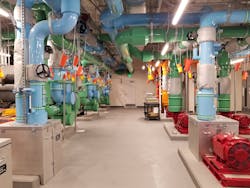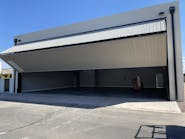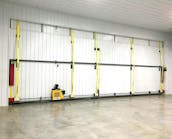The Salt Lake City International Airport (SLC) opened its new terminal complex in 2020, modernizing their 60-year-old facilities to meet the increased passenger demands of the present, said Bill Wyatt, executive director of the Salt Lake City Department of Airports.
“Salt Lake City International Airport served more than 27 million passengers in 2019, in facilities that were constructed 60 years ago to handle 10 million passengers per year. As a hub operation with numerous flights arriving and departing around the same time, the previous design was no longer efficient. In addition, security needs are vastly different from when the airport was originally constructed, and buildings no longer met earthquake safety standards,” explained Wyatt, who added that the project costed $4.1 billion, with “no local taxpayer dollars were spent on the construction.”
A major part of the modernization project was the introduction of a new innovative central Preconditioned Air (PCA) system design by AERO Systems Engineering (ASE). PCA systems provide air conditioning to parked aircraft during ground support operations.
“This is one of the most substantial and cutting-edge central plant designs in the United States in the last decade,” said Vern Landrum, senior mechanical engineer at ASE.
Most PCA central plants are two-pipe systems, where there is a single plant that provides heating and cooling with a single set of supply and return piping. The SLC design is a four-pipe central PCA plant utilizing separate heating and cooling systems, each with their own set of supply and return piping. This four-pipe design allows for an immediate transition between the cooling and heating operation at the concourse gate PCA unit, without the transition delay inherent to a two-pipe system, where the entire fluid volume in the system has to be heated or cooled by 120-degrees resulting in lost time and wasted energy.
“Salt Lake City’s weather is prone to large temperature swings throughout the day. It could range from freezing overnight to a more moderate temperature by midday; and for this reason, the airport wanted a fast-reacting PCA plant design,” said Landrum. “This ability to transition quickly between heating and cooling was a top design priority and that’s where this PCA plant excels.”
Another key design feature of the SLC PCA central plant is the system’s built-in redundancy. An issue that affects many central PCA systems is if a pump fails, it takes the entire PCA plant with it. SLC’s plant was built with dual pumps at each pump location to eliminate this risk. “Every pump we have here has a redundant spare, so to speak. So that if there is a pump failure it automatically swaps over from the faulty pump to the spare, to allow repair without shutting down the PCA plant. We also have controls in place that balance run hours on all equipment. We have endeavored to design this system to be as bulletproof as possible,” Landrum said.
Building in this redundancy was one of the requests SLC had for ASE when the company first began designing the project in 2014. Construction for the project began in 2017, and currently two PCA plants are online at the airport – the South Concourse West plant and the North Concourse plant. The third is the South Concourse East plant which is currently under construction. Once online, all three PCA plants will work in tandem, serving a combined 78 gates.
“It was clear during design that SLC wanted to incorporate innovation by implementing the latest and greatest sustainable technologies.” Landrum said.
“The building air conditioning system uses a free cooling scenario with Indirect/Direct Evaporative Cooling (IDEC) units. Since SLC has relatively low humidity, they are able to use cooling tower water for comfort cooling of the airport concourses. After the tower water goes through the comfort cooling IDEC units, it comes our way,” Landrum described. “… at which point that water cools our PCA chillers and returns to the cooling tower.”
“We worked in combination with Colvin Engineering on this effort to essentially synchronize our PCA plant with their IDEC system, and make sure that everything was sized effectively, to handle both the free cooling for comfort cooling in the concourse, as well as the heat rejection for PCA plant chillers.” he continued.
“By using a 30 percent propylene glycol mixture with water, the PCA system is more environmentally friendly than the typical ethylene glycol solution. There are 2,500 ton-hours of thermal storage per plant that is used to shift power usage from high peak rate hours during the day to the lower cost off-peak rates at night.” Additionally, the thermal storage allows for some redundant cooling capacity in the event of a chiller outage.
“Because we have a significant efficiency advantage over the DX point of use style units, we were able to earn multiple LEED Energy and Atmosphere credits. Using the central plant over the DX units helped this project advance from a Silver to a Gold LEED rating,” Landrum added.
As this was a LEED project, it required a lot more monitoring functionality to track energy usage on top of the built-in monitoring that comes from tying the three PCA plants together.
“You can look at any gate on the three concourses from any of the monitoring stations. That gives the end user a lot more information on whether an air handler is doing its job. They can do quite a bit of troubleshooting of the system before they dispatch maintenance to a gate to fix a problem,” said Landrum.
As with most projects, the team came across some unexpected hurdles, but each came with its own silver lining. An earthquake struck the airport, which put to test all of the earthquake resistant design requirements and standards.
“We designed per current earthquake codes and standards and then it was tested right away,” said Brain Murphy, Senior Mechanical Engineer, ASE.
Aside from a water leak in the existing terminal, no significant damage was sustained from the tremor in the new concourses.
“During construction Salt Lake City experienced a 5.7 magnitude earthquake, the epi center of which was not far from the SLC Airport. Fortunately, the construction project did not suffer any major damage. Only some loose ceiling tiles and shaken nerves,” said Wyatt.
“It was proof that designing for those contingencies most certainly does work. We were able to minimize any issues that could have potentially resulted if we were under old codes, or old earthquake standards,” said Landrum.
The largest unknown the team had to tackle was the COVID-19 pandemic, but even the impact of the virus came with a small upside of speeding up the construction phases.
“COVID impacted how the project was phased due to reduced airline traffic and trying to take advantage of that reduction in the flight schedule. Originally, the plan was to take down one terminal at a time, transferring aircraft to the new gates as they demolished section by section. The decline in air travel made it possible for the existing concourses to be demolished all at once. So basically, it helped the team speed up the phasing. However, additional regional jet parking capacity was still needed and required us to develop temporary hardstand positions with the SLC design team,” Murphy said.
“The program began taking temperatures prior to anyone entering the construction site, required the wearing of face masks and physical distancing while on the premises. Constructing a new facility around an operating facility created unique phasing challenges,” said Wyatt.
As for future construction, the design is complete for South Concourse East and construction is now ongoing.
“The New SLC Redevelopment Project is well underway in building Phase II of the program. This entails demolishing the existing airport to make way for the east portion of Concourse A, as well as building a Central Tunnel to Concourse B. The airport is currently updating its Master Plan, which references plans for Concourse C in the future,” said Wyatt.
“Additional gates are needed as soon as possible for the future concourse, so we’re working with the design team to phase the construction to open a few of the gates a little early rather than all at once when the building is complete,” Murphy added.
For airports wondering if a PCA system like the one designed for SLC would work for them, Landrum noted, if a system is serving only a few gates (approximately eight gates or less), then DX units make sense. But as the number of aircraft gates serviced increases, then the efficiencies of a centralized PCA system should be seriously considered due to the long-term savings in energy use and operating cost.
“Central systems do cost more upfront, but the benefits add up over time, especially now that we're putting in redundancies on all pumps, and some chillers. We’re also utilizing thermal storage for additional redundancy and electrical demand shaving with the ability to shift power costs to more economical time of day rates,” Landrum continued. “You just have more sustainability and efficiency options with central plant technology.”
Landrum noted that an airport should always look at the overall life cycle cost of the different types of PCA equipment. Point of use units typically have about 10 years of expected useful life, and central PCA systems are at least double that. “SLC took time to really look at what made the most sense for their airside system options early on during the schematic design process. All too often a quick decision focused solely on the upfront cost is made regarding how PCA will be implemented for an airport. Although there is a significant initial capital investment required for a central PCA system, they usually pay for themselves in a relatively short amount of time through lower utility cost and maintenance savings. By going Central PCA, we are then able to achieve other important certification elements like a LEED Gold rating, as well as qualifying for construction rebates like the ones that were available from Rocky Mountain Power’s WattSmart program,” Landrum added.
“The airport now exceeds seismic standards and is more sustainable, in fact we are working towards LEED Gold Certification. In addition, the linear configuration creates a more efficient design for aircraft since multiple planes are able to move in and out of the gate area at one time,” Wyatt said.





